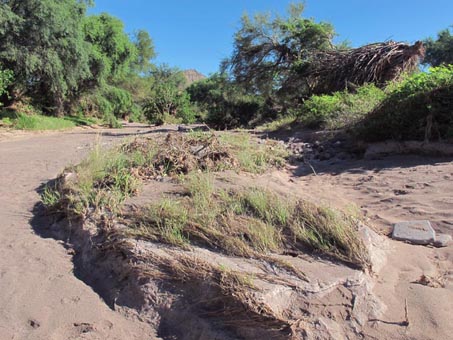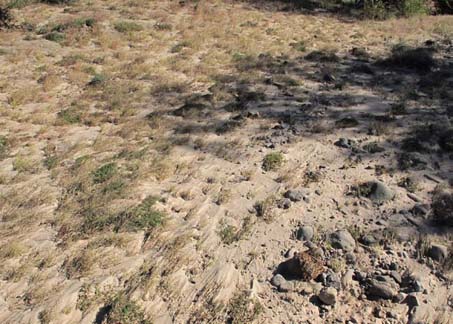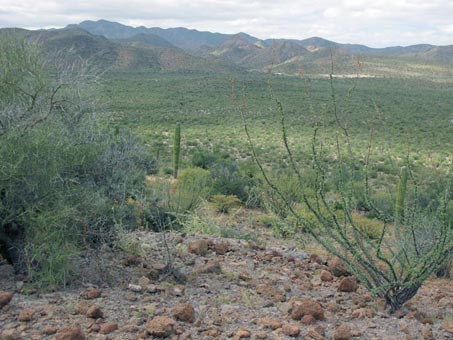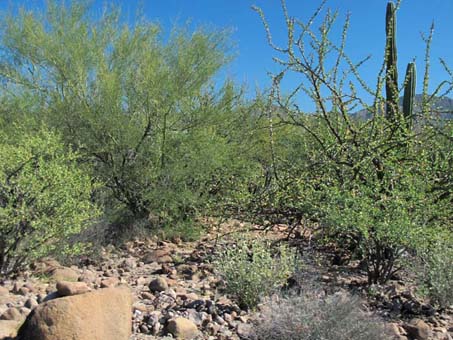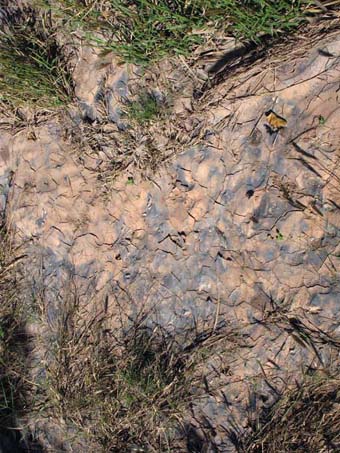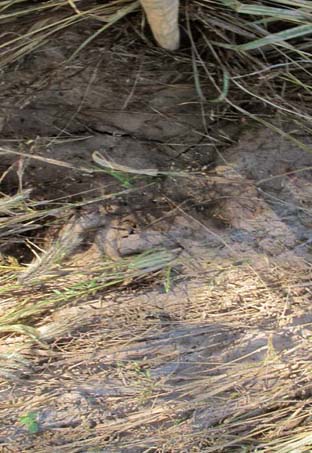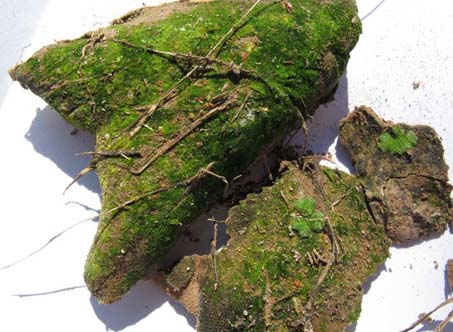BEE JANUARY 2013
After the Rains – Bryophytes in the Desert
Mulegé, Baja California Sur – Nov 30 - Dec 10, 2012
Mulegé is located on the Gulf Coast approximately 2/3rds of the way down the peninsula and lies within what is known as the Central Gulf Coast phytogeographic region of the Sonoran Desert. As such, the climate is generally hot and dry, though the summer weather is intermittently affected by monsoonal weather patterns from the tropics (the tip of the peninsula lies just within the tropics). Along much of this part of the Gulf coast, summers are not only hot, but very humid, with humidity dropping as one moves inland into the drier interior.
Following the rains that fell between August and early October, there was a great deal of herbaceous growth right afterwards. Unfortunately, much of it was destroyed in the Mulegé Valley Oct 16-17 during the flood, in which quickly flowing water covered most of the valley basin. Evidence of this was quite clear both in and out of the multiple river courses.
Beyond the Mulegé Valley, where flooding is not as wide-spread a problem, and where only the smaller arroyos suffer from the heavy rains and runoff, the plants on the desert flats or gentle slopes and dunes were actually able to make good use of the water. Most of the trees were green when we arrived. While the weather was hot for about another month, the gradually cooling temperatures have allowed the trees to continue to thrive and they are becoming even leafier.
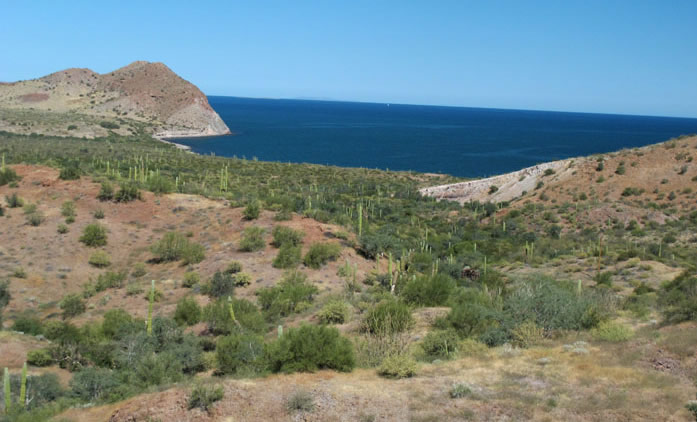
View of Gulf of California from Cuesta El Tiburón, Hwy 1 just south of Mulege, BCS.
Mesquite (Prosopis glandulosa var. torreyana), Palo Verde (Parkinsonia microphylla), Palo Blanco
(Lysiloma candidum), and
Cardón cacti (Pachycereus pringlei) dominate the scene from this distance.
Bryophytes in the Desert?
When we finally arrived in town three weeks after the flood, there was still evidence of the water, especially in shady areas. While I was hoping to find some bryophytes (mosses and liverworts) with all the residual moisture, I wasn't totally confident that I'd be able to find the right place or places for them in time with so much ground to cover. I put looking for them at the top of my list in the hopes of finding some before the ground dried up too much and they disappeared. Well, not to fear.
On an early trip one morning I drove through the palm orchard which lies in the bottom of the main river course. It is dark and well-vegetated there, but the soil is usually bone dry and powdery. That morning however, as I was passing, I saw a large pool filling the bottom of a small side channel of the river that was in deep shade. Squishing my way over to it through the wet soil and high grass, I could see that besides the clouds of mosquitos hovering over and around it, its banks were covered in a green fuzz. As I started to look around more in the orchard, I saw that there were in fact many areas where the ground was damp and green.
On closer inspection I could easily distinguish some mosses and a liverwort species. However, much of what I thought at first was a mossy soil covering may actually be some type of filamentous algae, though I am unable to magnify the sample enough to really visualize possible minute mosses or lichens or other organisms present. Vouchers will go to the appropriate experts for identification and curation.
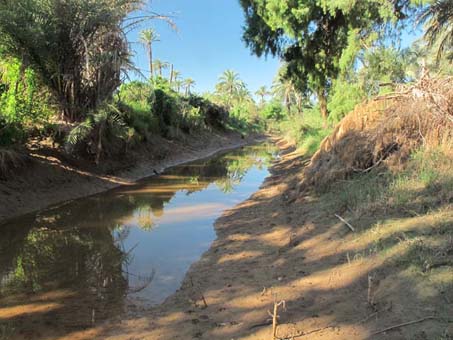
Standing water in small channel of river passing through palm orchard.
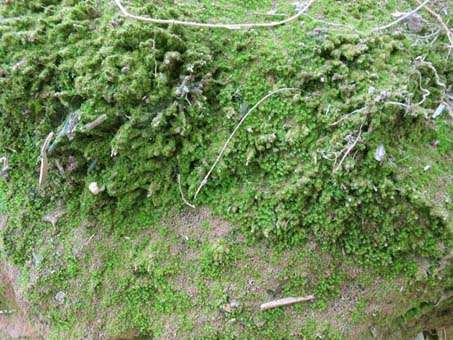
Closeup of the mossy bank.
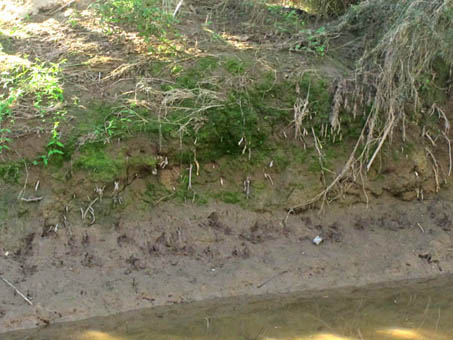
Mosses and liverworts on bank. This seems to be a well- established colony, with the moss showing new growth on top of the old.
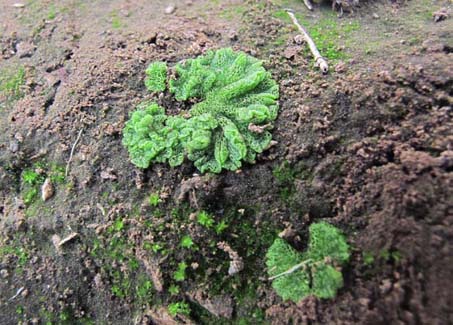
Riccia cavernosa, a small liverwort.
Even with my limited [i.e. non-existent] bryophyte knowledge, I have been able to distinguish
at least three different species of moss, one with minute, rounded leaves
and long stems, growing in dense colonies; a second with wide, tongue-like leaves; and the third with pointed
leaves ending in tiny spines. I had to get my rubber boots out
of storage to squish over to see these on the bank, risking getting stuck in
the heavy, slick mud. For safety, I left the camera behind on the first trip,
and it wasn't until a week later that I finally was able to confidently get close enough to take these photos.
The larger liverwort (photo right, above) is just under an inch wide. This species grows in circular patches that apparently can reach about 3 cm in diameter. The surface is pitted, and the thallus ruffled. There are also some tiny mosses, the ones with rounded leaves.
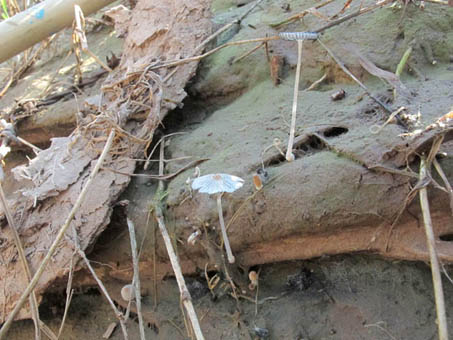
Also growing on a nearby bank were a number of different fungi. How many can you find?
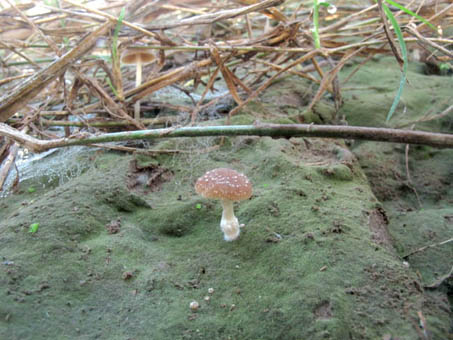
A green carpet: biological soil crust formed here mainly by what I think is a filamentous algae, along with the fungi, liverwort and a few
moss species. As parts of it dry up, it turns a grayish blue or black.
I have also found a number of areas in the dry wash in desert scrub farther out in the valley where the biological soil crust is still very evident. Looking under the matted grasses and other herbs flattened by the flood brought some unexpected treasures.
A closer view of a piece of biological soil crust taken from underneath a layer of dead grasses in deep shade. The crust popped right off the ground in an undulating piece about 1/4th inch thick, the margins curled under. I was hoping to find some mosses, but it seemed to just be algae. The roundish patches on the right two pieces are the liverwort Riccia cavernosa. The bright green is very velvety.
Field Notes – Dec. 10
Mosses, liverworts and algae are still thriving in the orchard in the river bed almost 8 weeks after the flood! I thought they'd be long gone by now, given the heat and dry air. The soil is still quite damp, but no longer as squishy as in the previously submerged places. Some of the mosses have actually become greener in the last week and now have fruiting bodies.
Even though experts told me that bryophytes occur in Death Valley, I was skeptical about their existence here in the Baja California desert until I´d seen some for myself. We found our first mosses in the desert a few years ago, dried and blackenend encrustations on the granite boulders of Cataviña, at several thousand feet elevation and much cooler winter temperatures. Then this past spring I found some in the "foothills" of the sierras west of town at about 600 feet, near an intermittent stream. The search was still on though, for the elusive mosses of Mulegé.
It wasn¨t until this month that I was successful at finding them not only in a riparian area where I would more likely expected to find them, but also at more or less sea level in one of the driest desert habitats of the peninsula.
So OK, Jim Shevock and Dan Norris of UCB-Jepson Herbarium, you were both right. I´m a true believer now: that bryophytes are everywhere. Thanks for insisting I not give up the search!
Hasta la proxima!
— Debra Valov, curatorial volunteer


